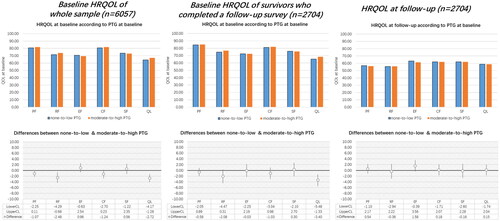Figures & data
Table 1. Baseline characteristics of samples at baseline study and follow-up study.
Table 2. Tests of effects on longitudinal relationship between benefit finding and health-related quality of life (functional scales and global health status/QOL of EORTC QLQ-C30).
Table 3. Tests of effects on longitudinal relationship between posttraumatic growth and health-related quality of life (functional scales and global health status/QOL of EORTC QLQ-C30).
Figure 1. Distribution of HRQOL scores in none-to-low and moderate-to-high BF group (upper line) and the differences of HRQOL between none-to-low and moderate-to-high BF (lower line). Note. HRQOL: health-related quality of life; BF: benefit finding. PF: physical functioning; EF: emotional functioning; CF: cognitive functioning; RF: role functioning; SF: social functioning; QL: the global health status/quality of life. LowerCL/upperCL: lower level/upper level of 95% confidence interval on the HRQOL difference between none-to-low group and moderate-to-high BF group. Baseline HRQOL was adjusted for cancer type, sex, age at survey, education, time since diagnosis, UICC stage, comorbidities, and active cancer disease. Follow-up HRQOL was adjusted for baseline HRQOL, other baseline variables (cancer type, sex, education, UICC stage), and follow-up variables (age at survey, time since diagnosis, comorbidities, and active cancer disease).

Figure 2. Distribution of HRQOL scores in none-to-low and moderate-to-high PTG group (upper line) and the differences of HRQOL between none-to-low and moderate-to-high PTG (lower line). Note. HRQOL: health-related quality of life; PTG: posttraumatic growth. PF: physical functioning; EF: emotional functioning; CF: cognitive functioning; RF: role functioning; SF: social functioning; QL: the global health status/quality of life. LowerCL/upperCL: lower level/upper level of 95% confidence interval on the HRQOL difference between none-to-low group and moderate-to-high PTG group. Baseline HRQOL was adjusted for cancer type, sex, age at survey, education, time since diagnosis, UICC stage, comorbidities, and active cancer disease. Follow-up HRQOL was adjusted for baseline HRQOL, other baseline variables (cancer type, sex, education, UICC stage), and follow-up variables (age at survey, time since diagnosis, comorbidities, and active cancer disease).

Supplemental Material
Download MS Word (56.1 KB)Supplemental Material
Download MS Word (478.3 KB)Data availability statement
Due to the nature of the research, ethical supporting data are not available.
